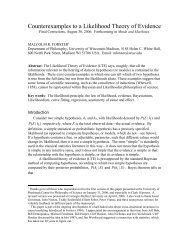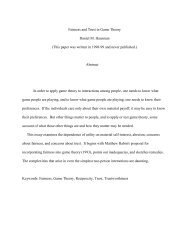1 What does a confidence interval mean? Elliott Sober Suppose you ...
1 What does a confidence interval mean? Elliott Sober Suppose you ...
1 What does a confidence interval mean? Elliott Sober Suppose you ...
Create successful ePaper yourself
Turn your PDF publications into a flip-book with our unique Google optimized e-Paper software.
Confidence <strong>interval</strong>s are regarded as <strong>interval</strong> estimates. For example, the<br />
statement that [5,7] is a 95% CI is usually taken to <strong>mean</strong> that [5,7] is a “good” <strong>interval</strong><br />
estimate of Θ. This might lead <strong>you</strong> to think that there is a probability statement that has<br />
the proposition “Θ falls in the <strong>interval</strong> [5,7]” in it somewhere, and which assigns to the<br />
probability in question a value of 0.95. Let us consider some options concerning what<br />
this probability statement might be:<br />
(1) Pr(Θ is between 5 and 7│the sample <strong>mean</strong> is between 5 and 7) = 0.95.<br />
(2) Pr(the sample <strong>mean</strong> is between 5 and 7│Θ is between 5 and 7) = 0.95.<br />
(3) Pr(the sample <strong>mean</strong> is 6│Θ is between 5 and 7) = 0.95.<br />
(4) Pr(Θ is between 5 and 7│Θ = 6) = 0.95.<br />
None of these statements correctly describes what it <strong>mean</strong>s for [5,7] to be a 95% CI for<br />
Θ. Statement (1) assigns a posterior probability to the <strong>interval</strong> estimate of Θ. But<br />
<strong>confidence</strong> <strong>interval</strong>s are not Bayesian and principle (T) <strong>does</strong>n’t assign a posterior<br />
probability to any <strong>interval</strong> estimate. Statement (2) improves matters; at least the claim<br />
about the unknown parameter Θ is on the right side of the conditional probability sign.<br />
But (2) isn’t what it <strong>mean</strong>s to say that [5,7] is a 95% CI. Notice that the hypothesis<br />
described in (2) – that Θ is between 5 and 7 -- is composite; there are many ways that Θ<br />
can be between 5 and 7. The same is true of statement (3); however, the probability of<br />
obtaining a sample whose <strong>mean</strong> value is exactly 6 is zero if the population is normal and<br />
has a nonzero standard deviation. So (3) is false. And so is (4); as already noted, the true<br />
value of the conditional probability it describes is unity, not 0.95.<br />
Proposition (T) describes what it <strong>mean</strong>s to construct a 95% CI. It says that if <strong>you</strong><br />
apply this procedure of construction to different data sets drawn from the same<br />
population (as the figure depicts), <strong>you</strong> can expect to construct <strong>interval</strong>s that include the<br />
true population <strong>mean</strong> about 95% of the time. When <strong>you</strong> use this procedure on the single<br />
data set at hand, <strong>you</strong>’re using a procedure that has a probability of 95% of producing an<br />
<strong>interval</strong> that includes the true value. But this statement about the procedure <strong>you</strong>’re using<br />
<strong>does</strong>n’t allow <strong>you</strong> to make a probability statement about the <strong>confidence</strong> <strong>interval</strong> <strong>you</strong><br />
construct. The <strong>interval</strong> [5,7] either includes Θ, or it <strong>does</strong>n’t. All that can be said of the<br />
<strong>interval</strong> [5,7] is that it was constructed by a procedure that is described by (T). The<br />
probability claim can be made about the procedure of constructing a <strong>confidence</strong> <strong>interval</strong>,<br />
not about the <strong>confidence</strong> <strong>interval</strong> <strong>you</strong> construct.<br />
4




